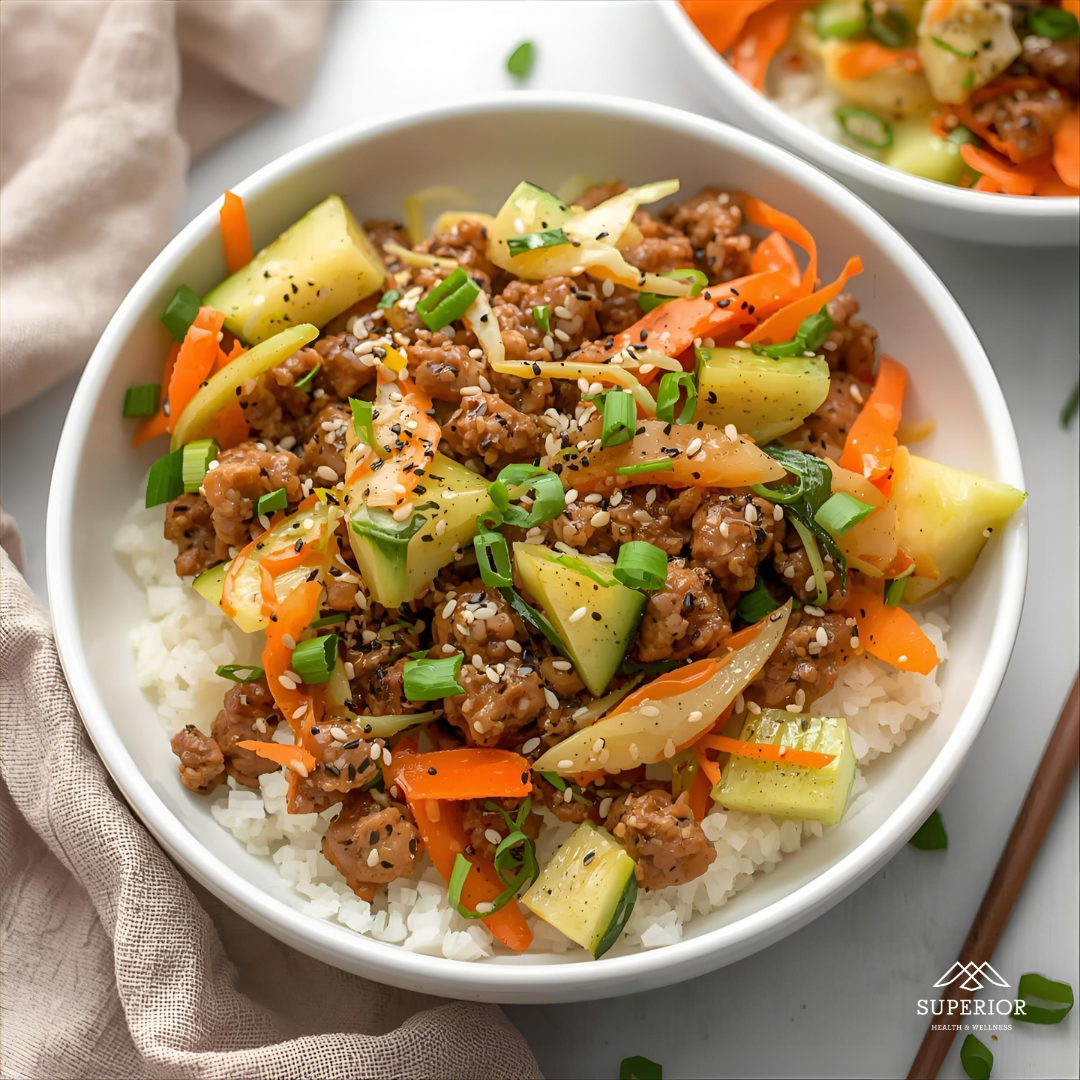How to Reduce GLP-1s GI Side Effects with Food, Lifestyle, and Supplements
Disclaimer: The content provided on this website is for informational and educational purposes only and is not intended as a substitute for professional medical advice, diagnosis, or treatment. The information presented does not constitute medical recommendations and should not be used to guide clinical decisions. Always seek the advice of a licensed healthcare provider regarding any medical condition or treatment. Do not disregard or delay professional medical care based on information found on this site. This content mentions weight loss medications which may include compounded medications that have not been reviewed by the FDA for safety or effectiveness; no therapeutic claims are made for these products. This content includes the name of a prescription medication but does not describe its uses, benefits, or risks. Visuals are for illustrative purposes only; individuals shown are not actual patients. Individual results may vary.
The Gut Impact of GLP-1s
GLP-1 receptor agonists and dual GIP/GLP-1 receptor agonists, such as semaglutide (Ozempic®, Wegovy®) and tirzepatide (Mounjaro®, Zepbound®), have transformed the landscape of weight loss and metabolic health. These medications mimic natural gut hormones that regulate blood sugar, appetite, and digestion. While highly effective for most, many people experience uncomfortable gastrointestinal (GI) side effects—most commonly nausea, constipation, diarrhea, bloating, and reflux—as well as fatigue, and sometimes nutrient depletion if appetite suppression leads to reduced intake¹.
The good news?
With intentional food choices, lifestyle adjustments, and targeted supplements, you can minimize, or even prevent, discomfort and make your medication experience much smoother.
Eat Smarter
Foods That Reduce GLP-1 Gut Side Effects
Because these medications slow gastric emptying, what you eat and how you eat can greatly affect your symptoms:
Smaller, slower meals: Eating modest portions more frequently and chewing thoroughly reduces nausea and feelings of fullness. Avoid rushing through meals, as slower eating gives your body time to signal satiety, reducing the chance of nausea or discomfort¹.
Protein + gentle fiber: Pair lean protein (chicken, fish, eggs, tofu) with soluble fiber, like cooked vegetables, to feel satisfied without overwhelming digestion². Avoid increasing fiber intake significantly in a short amount of time to reduce bloating and upset.
Cooked, not raw: Many people tolerate lightly cooked vegetables, soups, and stews better than large amounts of raw produce, which can cause bloating².
Skip greasy, fried, and highly-processed foods: These often worsen nausea, reflux, and diarrhea¹.
Stay hydrated: While individual hydration needs vary, a good rule of thumb is to aim for at least ½ of your body weight in ounces of unsweetened/caffeine-free fluids daily and add electrolytes if you notice fatigue, headaches, or constipation².
These adjustments may not only reduce discomfort but also help maintain steady nutrient intake during times of reduced appetite.
Calm Your Gut
Lifestyle Tips for Managing GLP-1 Side Effects
Simple daily habits can significantly reduce the intensity of GI side effects:
Take a gentle walk after meals: Even 10–15 minutes can improve digestion and reduce reflux³.
Eat earlier in the evening: Give your stomach 2–3 hours to digest before lying down³.
Practice stress relief: Breathing exercises, meditation, or yoga help manage stress that worsens gut sensitivity and slows motility³.
Prioritize sleep: Consistent, restorative sleep supports energy and helps regulate appetite³.
Ease Discomfort
Best Supplements for GLP-1 Digestive Support
Supplements should always be personalized, but certain options have shown benefit in supporting gut and metabolic health:
Ginger and peppermint: Both have long histories of being used for supporting digestive comfort and reducing nausea⁴.
Digestive enzymes: High-quality digestive enzymes help break down proteins, fats, and carbohydrates, which may ease bloating⁴.
Magnesium (citrate or glycinate): Supports regular bowel movements and muscle relaxation. Magnesium citrate is more effective for constipation, while glycinate is gentler and also aids sleep⁴.
Probiotics: Supplementing with a quality probiotic may restore gut balance, especially when diarrhea or bloating is present⁵.
Essential nutrients: A high-quality multivitamin and omega-3 supplement help fill nutrient gaps from reduced appetite⁴.
B-complex vitamins: Aid energy metabolism, especially if calorie intake is low⁴.
Working with a provider to choose the right supplement regimen ensures both safety and effectiveness.
Making GLP-1 Therapy Work for You
GLP-1 and dual GIP/GLP-1 receptor agonists are powerful tools for weight management and metabolic health, but the gastrointestinal side effects can sometimes feel discouraging. The good news is that with intentional food choices, small lifestyle adjustments, and the right supplement support, you can ease discomfort and stay consistent with your treatment plan. These strategies not only make your journey smoother but also help protect nutrient intake, energy levels, and overall well-being.
Superior Health & Wellness specializes in creating personalized care plans that support patients on compounded medical weight loss therapy. Whether you’re struggling with nausea, bloating, or fatigue—or simply want guidance on nutrition and supplements—we’re here to help you get the best possible results.
Book a FREE Care Call Today to explore how we can help you feel your best.
GLP-1 Friendly Recipes for Digestion
Making small adjustments to your meals can go a long way in reducing common GLP-1 side effects like nausea, bloating, and constipation. The following recipes are designed with gentle ingredients and simple preparation methods that support easier digestion—helping you stay nourished and comfortable while on your treatment journey.
Chicken Burrito Bowl (2 servings)
Ingredients
1 lb (450 g) shredded chicken breast
Prep options:
Quick cook: Boil 1–2 chicken breasts in water or broth for 15 minutes, then shred with two forks.
Shortcut: Use pre-cooked rotisserie chicken, remove skin, and shred.
2 cups cauliflower rice, cooked until soft
Seasoning ideas: cilantro, lime juice, pinch of salt
1 cup spinach or 1 cup shredded cabbage, lightly steamed
Optional Additional Vegetables (soft-cooked for digestion):
½ cup zucchini, diced
½ cup carrots, diced or shredded
½ cup mushrooms, sliced
Bell peppers, lightly sautéed until soft
Seasoning:
Salt to taste
Taco seasoning (homemade or store-bought)
Toppings (per serving):
¼ avocado, sliced (~30 g)
2 tbsp plain Greek yogurt (unsweetened)
1 tsp fresh cilantro, chopped
1–2 TBSP Cotija or Queso Fresco cheese
Lime wedge
Instructions
Prepare the Chicken: Warm shredded chicken in a skillet over medium heat. Sprinkle ~1 tsp taco seasoning over the chicken and stir to combine, add 1 TBSP of water as needed. Heat 3–5 minutes until warm.
Cook the Base (Cauliflower Rice): Heat 1 tsp avocado oil in a skillet over medium heat. Add cauliflower rice and sauté for 4–5 minutes until soft. Season gently with cilantro, lime juice, and a pinch of salt (or mild herbs like parsley) to keep it flavorful without irritating the gut.
Prepare Greens: Lightly steam spinach or cabbage for 1–2 minutes until just wilted. Avoid overcooking, which can make cabbage bitter.
Optional Veggies: Sauté zucchini, carrots, mushrooms, or soft bell peppers until tender (~3–4 minutes). Sprinkle ~1 tsp taco seasoning over the chicken and stir to combine.
Assemble the Bowl: Place cauliflower rice as the base in each bowl. Layer lightly steamed greens on top, then the optional soft vegetables. Add half the shredded chicken to each bowl.
Add Toppings: Finish with avocado slices, a small dollop of Greek yogurt, fresh cilantro, and a squeeze of lime.
Egg Roll in a Bowl (2 servings)
Ingredients
1 lb (450 g) lean ground chicken or turkey
1½ tsp freshly grated ginger (or 1 tsp ground ginger)
½ tsp garlic-infused oil (optional; easier to digest than raw garlic)
3 cups shredded Napa cabbage or spinach (lightly steamed)
½ cup shredded carrots (optional; steam for easier digestion)
½ cup zucchini, diced
2 tsp low-sodium soy sauce or coconut aminos
1 tsp sesame oil (can omit if sensitive to fat)
1 tsp avocado or neutral cooking oil
Salt and pepper to taste
Optional garnish per serving: 1 tsp chopped green onion, 1 tsp sesame seeds
Instructions
Cook the Meat: Heat 1 tsp avocado oil in a large skillet over medium heat. Add lean ground meat and cook until fully browned, breaking it into small pieces.
Add Flavor: Stir in ginger and garlic-infused oil. Cook 1–2 minutes until fragrant.
Add Vegetables: Add cabbage, carrots, and zucchini. Cover for 2–3 minutes to slightly steam and soften vegetables for easier digestion.
Season: Add soy sauce (or coconut aminos), sesame oil, and a pinch of salt and pepper. Stir to combine and cook 1–2 more minutes.
Serve: Divide into two bowls. Top with green onions and sesame seeds if tolerated. Optional: serve over ½–1 cup cauliflower rice for added low-glycemic fiber.
FAQ: Managing GLP-1 Side Effects
-
Smaller, protein-focused meals with cooked vegetables are easier to tolerate. Avoid greasy or highly processed foods that worsen nausea and reflux.
-
Stay hydrated, include gentle soluble fiber, and consider magnesium or probiotics (with provider approval).
-
Most patients notice GI symptoms improve after the first few weeks, but strategies like smaller meals and supplement support can make the adjustment smoother.
Have questions before getting started?
Disclaimer: The content provided on this website is for informational and educational purposes only and is not intended as a substitute for professional medical advice, diagnosis, or treatment. The information presented does not constitute medical recommendations and should not be used to guide clinical decisions. Always seek the advice of a licensed healthcare provider regarding any medical condition or treatment. Do not disregard or delay professional medical care based on information found on this site. Some services may involve compounded medications that have not been reviewed by the FDA for safety or effectiveness; no therapeutic claims are made for these products. Visuals are for illustrative purposes only; individuals shown are not actual patients. Individual results may vary.
This content includes the name of a prescription medication but does not describe its uses, benefits, or risks. This content does not include therapeutic claims and is intended only to identify the product. This drug may not be appropriate for all patients. Visuals are for illustrative and marketing purposes only. Individuals shown are not actual patients. You are encouraged to report negative side effects of prescription drugs to the FDA. Visit MedWatch or call 1-800-FDA-1088.





